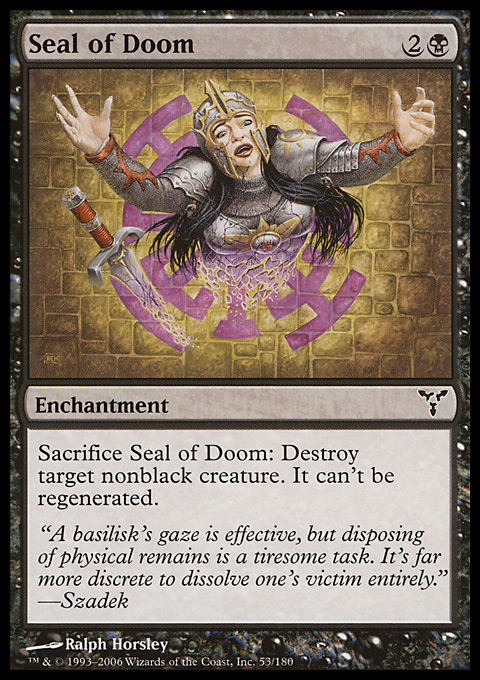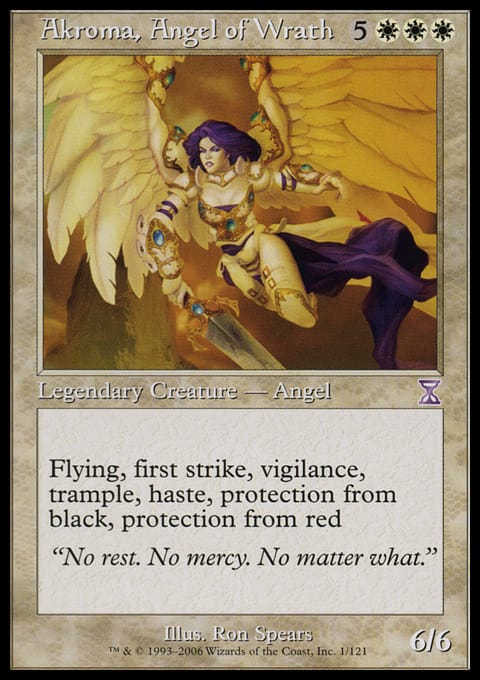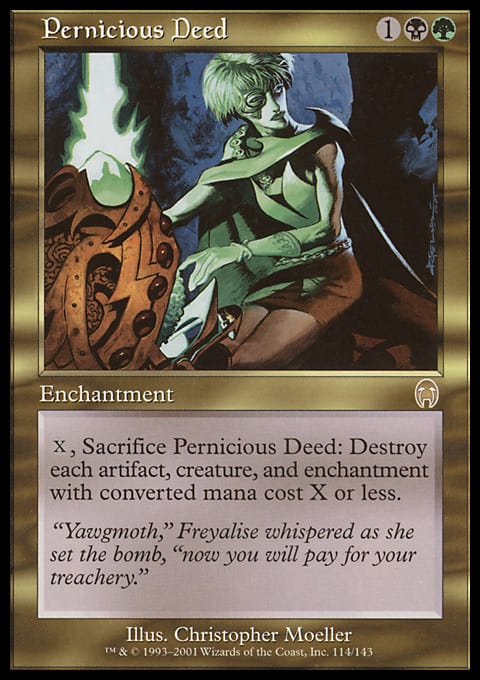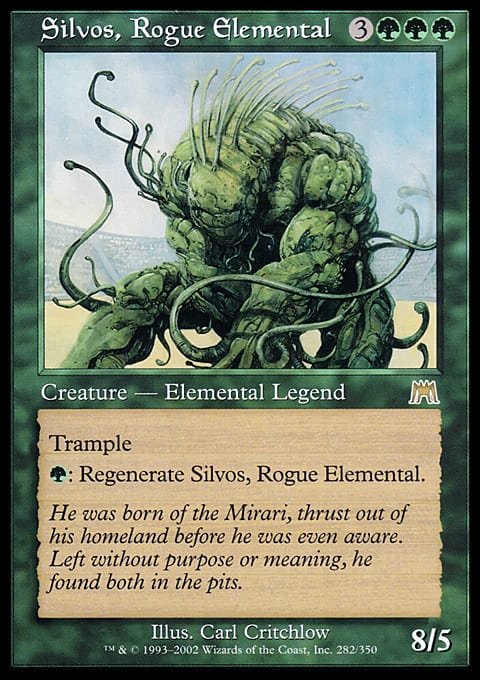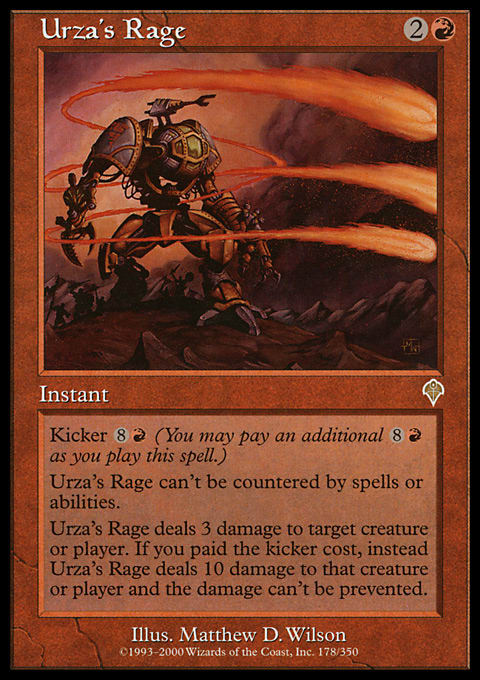For the last two months, I’ve brought to your four articles on five different ways to look at Magic cards in a multiplayer environment. Today, I am going to look at the final way, and then I’ll look at how cards are rated in more than one way. By understanding these six elements, you will be in a better place to evaluate the worth of various cards in your deck-building for multiplayer.
To begin, these are the five animal elements of cards we’ve examined thus far:
Rattlesnake – This element warns people from attacking or coming after you by threatening harm. Examples include Seal of Doom and Nevinyrral's Disk.
Spider – A spider card comes out of nowhere to blast someone or his stuff when things become unruly. Examples include Rout and Krosan Grip.
Cockroach – A card rated highly as a cockroach has an ability or lingers on the board for a long period of time, and over numerous uses in the game, it creates enough momentum to help you win. Examples include Yavimaya Hollow and Compulsion.
Plankton – Just as plankton are near the bottom of the food chain and serve as food for a lot of organisms, cards that are plankton help everyone at the table. Examples include Howling Mine and Veteran Explorer.
Pigeon – Since pigeons seem to grow their flocks in direct proportion to the populations of humans around them, so do pigeon cards improve with the more enemies you have. Examples include Lord of Extinction and Liliana's Specter.
To this list, we will be adding the final element: gorilla.
What Is a Gorilla?
This is a fairly easy element to understand. Subtlety is not exactly a gorilla’s modus operandi. Imagine that Return to Ravnica sees the printing of an homage to Watchwolf from the original Ravnica: City of Guilds. This one is Greater Watchwolf, and it costs
If you played Greater Watchwolf at the multiplayer table, it would seem like a good card. But it’s not ranked highly in any of the previous elements. It doesn’t keep people from attacking (although it does a bit since the turn it’s played, people won’t attack in with their smaller stuff), and it doesn’t come out of nowhere to blow something up. It doesn’t improve with more players, nor does it help everyone out. Finally, it doesn’t linger on the board for turn after turn like an indestructible creature might. Why is Greater Watchwolf good?
Because it rates highly as a gorilla. A gorilla is any card that has a huge interaction with the board. Gorilla spells swing the game, and gorilla creatures dominate the red zone. Let’s take a look at each.
Akroma, Angel of Wrath is a powerful gorilla because she’s a 6/6 with about twenty-nine abilities. She’s played a lot not because she’s sneaky, but because she dominates the red zone. Other examples of powerful gorillas are the various colorless Eldrazi creatures. Take a look at Kozilek, Butcher of Truth as a good example. Here’s a body that will smash face with a large power and toughness, and he also forces the sacrifice of a bunch of permanents every time he swings, which also has a powerful board presence. He’s like both halves of a gorilla combined!
There has to be a place in decks and multiplayer for sheer power. You need to have creatures that smash through defenses and win the game. To be fair, some creatures (such as Deep-Sea Kraken) are gorillas and unblockable, but many gorillas try to break through your defense either aerially or on the ground.
The next type of gorilla is the spell that has a massive impact on the game. The first sort is mass-removal spells. A Day of Judgment is a powerful gorilla because it destroys all creatures. That effect really impacts any multiplayer game. You can sweep enchantments, artifacts, certain types of creatures, or everything—it’s all gorilla. Whether we are discussing Armageddon, Fracturing Gust, or Earthquake, all of these effects are clearly powerful gorillas.
Spells that change the course of a game are not just limited to mass removal. There are many others out there. Perhaps none better exemplifies this than the spell Insurrection. This is a spell that often wins the game for the caster immediately. It gives you control of all creatures for the turn, and they gain haste. You can swing and hit multiple players with lethal damage. It’s clearly a powerful gorilla.
Other gorillas are spells that can steal multiple cards permanently (Blatant Thievery), destroy a good number of permanents (Decimate), take multiple turns in a row (Time Stretch), a card that nabs a bunch of cards to replace it (Recurring Insight), a card that makes an immediate army (Entreat the Angels), and so forth. Note that these spells usually have in common that they are providing you with massive potential for card advantage.
Many X spells have the potential to be gorillas as well. Putting 10 mana into a Diabolic Revelation is downright unfair. Even a simple Blaze aiming 10 at someone’s face is a clear gorilla. Some sweeping X-based removal, such as Hurricane or Magmaquake, have been mentioned prior. A Consume Spirit or Death Grasp will net you a lot of life while blasting a creature or opponent for damage. A Stroke of Genius is an obvious gorilla as you gain a smash-ton of cards. There are a few X spells that don’t rank as gorillas, such as Guardian Angel and Thrive, but for the most part, an X spell has every chance to be powerful.
How Does a Gorilla Interact with the Others?
Normally, my articles here would discuss how the animal type works—how a rattlesnake helps you win and so forth. Gorillas are obvious. They smash face or smash the board; either way, their impact is easily felt. Instead, I want to look at the interaction between gorillas and the other types.
The creator of these types was a multiplayer writer named Anthony Alongi. He created a scale to evaluate cards for multiplayer use. He would rank each card on the six different animal types numerically. Then, he would weight each animal type differently to come up with the best cards, but for today, we’ll mostly ignore weighing rattlesnakes more or spiders less. We’re also not going to rank cards numerically, but let’s consider what would happen if we did.
Anthony’s favorite multiplayer card for a long time was Pernicious Deed, so let’s look at that card right now. Imagine that we ranked each card 1 to 10 in every animal category. How would Pernicious Deed fall out?
I’ve already mentioned Deed in my rattlesnake article as a powerful rattlesnake. If someone wants to attack into the Deed, he risks having his stuff blown up. It should score a 7 or 8 on a rattlesnake because you have to keep your mana open to threaten with it, and you can’t sweep everything (an example of a 10 would be Nevinyrral's Disk, which just needs 1 mana and does blow up the whole world). It’s not a spider at all, so it ranks low there. It is not a cockroach because it doesn’t linger or use its ability multiple times—it has just one go. It’s certainly not a strong plankton either, but it does have some ability to help others under pressure, so it scores probably 4. It’s a good pigeon because the more players there are, the more it will destroy, so let’s give it a 6. Finally, it’s clearly a powerful gorilla—it can blow up the board. In fact, sometimes, you can scalpel it and leave some of your stuff that you want alone while still handling all of the things you care about. That’s a potent level of gorillaness, so let’s give it an 8. Our quick little survey of Deed gives it 8, 1, 2, 4, 6, and 8. That’s a strong level of power in multiple areas.
Gorilla creatures tend to be evaluated very highly in the gorilla rating and very low everywhere else. Consider Silvos, Rogue Elemental. Regeneration gives it some cockroach, maybe a 4, but other than that, it’s all gorilla and nothing else. Other similar cards include Terra Stomper and Fusion Elemental.
In order to find gorillas that are playable, you want those that are good in other elements as well. Let’s look more closely at the Akroma I mentioned earlier. Sure, she’s a good gorilla because she comes down and immediately smashes face. She’s also a keen rattlesnake as well. She remains untapped with vigilance, and her protection from red and from black keep any black or red creature from attacking. Her 6/6 first strike keeps any 5-power-or-less first striker from attacking, and any creature with 6 toughness or less is also held back. Her flying even keeps away aerial attackers. So, most creatures will just go attack someone else—very few creatures will survive combat with Akroma, and fewer still will kill her.
Another good example is Darksteel Colossus. Obviously, the fact that we have an 11/11 trampler shows that it’s a powerful gorilla. Then, add in that indestructibility, and you have a nasty cockroach effect on the card as well. The combination of both makes for a creature that is very tough to answer and slays foes with alacrity.
By finding creatures that are good in ways beyond gorilla, you find those creatures that you want for your deck. In multiplayer, winning is about maximizing the power of your cards. Make sure that your creatures do more than just smash face.
This is true about spells as well. Take Rout. It ranks highly as a very powerful spider as well as a sweepingly awesome gorilla. It’s more than just a Wrath of God. One of the ways you can verify that the animal aspect of analysis works is by checking it against established Magic theory. For example, let’s consider Disenchant versus Orim's Thunder in a multiplayer setting. Why is the Thunder better (assuming you’re playing white and red)? Because it has card advantage and flexibility. Why is it better with animals? Its ability to destroy more than one permanent gives it some gorilla rating (like a 3 or 4 maybe), while its spider ranking moves up because it can surprise a creature, too. The ratings improve with the Thunder, so it’s better in both for the same reason. That’s a nice way to double-check the theory.
Anyway, so gorilla spells should do more than stand as good primates. One I mentioned above was Blatant Thievery. Note that it steals one permanent from each opponent. You know what that means: it’s powerful as a pigeon. I’d give it an 8 or 9 in pigeon and a 7 in gorilla—the card is downright devastating in multiplayer. Another example of a gorilla/pigeon is Congregate, a gorilla on its own, but in multiplayer, the more players at the table, the more likely one is to gain a bunch of life with it. When you gain 30 life from a 4-mana instant, that’s a game-changer.
My two favorite cards from Scars of Mirrodin were two different types of cards: Darksteel Sentinel and Exsanguinate. The former is a potent rattlesnake, cockroach with a bit of spider. The other is a massively powerful gorilla and pigeon. Each is potent in its own right, but in very different ways. Today, I think the Sentinel is better, but they both have a lot to offer your decks. Try to find these interactions with your gorillas.
And More!
As the Darksteel Sentinel demonstrates, not just gorillas are helped by being strong in more than one animal element. The more a card is ranked in the various animal aspects, the more powerful it becomes, but with a caveat.
Plankton cards are a bit different. A lot of people have different takes on them. Bennie Smith, for example, loves them. In his articles, he is often talking about the power of keeping out Howling Mine and playing Prosperity. He likes cards that help everyone. Heck, just a few weeks ago, he talked about these sorts of cards at length. Other writers are not as keen. I am very wary of most plankton cards, and yet some of my favorites are plankton, such as Veteran Explorer. I wouldn’t be caught dead handing over more cards to my opponents with a Howling Mine, but I recently won a game in which I played Jace Beleren and used him for a long time, including the occasional card for everyone.
I think you need to be careful about plankton cards in multiplayer. Handing your enemies more cards than you net for yourself smacks of a bad strategy (assuming you are not combining it with stuff such as Underworld Dreams or Tainted Aether or whatever).
Still, the basic premise holds true: For the other five types, cards that are powerful in multiple areas are better choices for your deck. In fact, I’ll often take a card with a reduced ranking in one area to improve them in others. You can find a lot of creatures bigger than Woodfall Primus, so why bother with a 6/6 for 8 mana? Because you can destroy up to two permanents, and the persist gives you a modest cockroach ranking—that’s why! Acidic Slime is just a 5-mana 2/2 creature that pops an opposing permanent, so why is it so highly rated? Because the deathtouch turns into a nice rattlesnake as people don’t want to attack into you to lose their creatures.
In fact, playing cards that can be more if you need them and less when you need them is very important. To this day, Urza's Rage is one of the best burn spells to my mind. Like X spells or Congregate, it requires the right condition to be a gorilla. In this case, it needs a kicker of 9 mana. When you kick it, you can blast someone’s head with uncounterable and unpreventable damage; that obvious qualifies as a gorilla and a spider of high caliber. But when you play it early to burn a creature, it’s just a weaker spider. To my mind, that’s worth having. Not only can you spider/gorilla something late for a decade of damage, but you can also spider something early if you are threatened. Finding scalable cards such as these is important to having a card that truly works in multiplayer no matter the situation. Whatever the down and distance, Urza's Rage has a shot at converting.
I hope that you have learned something from today’s article. This is probably the last article I’ll do on these various animal aspects since we’ve examined all six. Now that you know them, you can find the best cards for your deck by finding out what is good in multiple areas. Once you’ve done that, your decks will improve at the kitchen table and your next Magic night. Let me know if you have any questions or comments!
See you next week,
Abe Sargent













